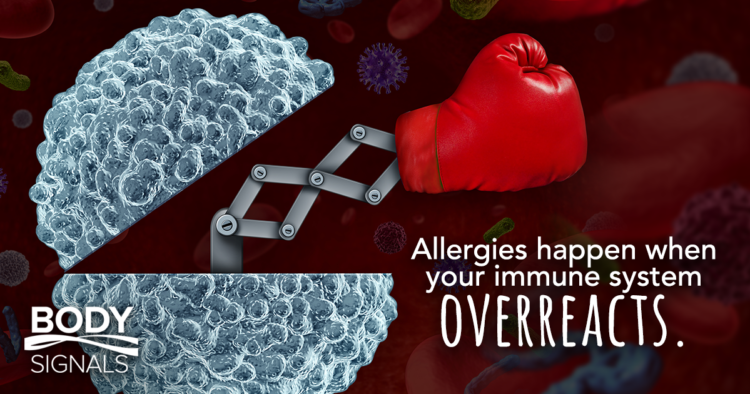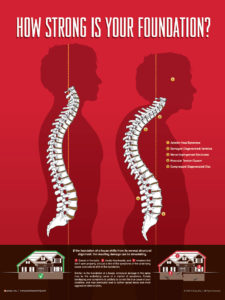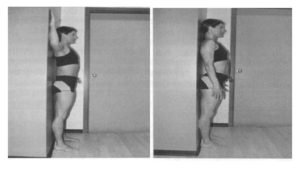August is here and so begins the ‘sneezing season’ for some allergy sufferers. Ragweed wreaks havoc on many this time of year. Itchy eyes and ears, sneezing, scratchy throats – it can be crippling.
What many people don’t realize is there is high levels of stress can cause your allergies to become worse. This has been confirmed by research in the field of psychoneuroimmunology. Mental stress can upset the balance of your nervous system and immune system. If your nervous system is overstimulated with stress, it can affect the response of your immune system to an allergen.
How is that possible?
Our nervous systems have two divisions – the sympathetic (gas pedal) and parasympathetic (brake pedal). You probably remember the terms ‘high or flight’ (sympathetic) or the ‘rest/digest’ (parasympathetic) from high school health classes. Both of these systems work simultaneously to keep us constantly adapting to changes in our bodies and outside our bodies every second of the day. Think of both systems working together like two kids on a teeter totter. Sometimes the sympathetic system needs to be ‘up’ and at other times, the parasympathetic system takes a turn working harder. Both offset each other to avoid one system becoming dominant.
So here’s how it affects you as an allergy sufferer. The sympathetic system is responsible for our response to allergens. When pollen or dust contacts the membranes of the nose or eyes, the body launches an immune assault to resist it. This drives up histamine. If the sympathetic system is overly dominant, then the histamine levels can be greater than necessary.
Schedules, finances, workloads, not enough exercise, poor diets, chemical stress and more can press down on our ‘gas pedal’ causing our system into sympathetic dominance.
So with that understanding, by decreasing mental, physical and chemical stress, your immune system can function better and head off many allergies at the pass.
Why it Matters:
Exciting new research has showcased how stress reduction can reduce the symptoms we associate with seasonal allergies. Meditation and chiropractic adjustments have been shown to reduce stress levels. And with reduced stress levels, your immune system has the potential to function at a higher level. Feeling more relaxed is something all of us could benefit from- and it may even help reduce your seasonal allergies.
– Physical, chemical, and emotional stress can cause your immune system to become hypersensitive.
– A hypersensitive immune system often overreacts to a potential threat resulting in worsening allergies.
– Reduce stress, and allergies, with a stress-reducing activity like exercise, meditation, or even getting chiropractic adjustments!
Next Steps:
Aside from putting you in a bad mood, being over-stressed has far-reaching effects on your body. If you “start to feel your allergies coming on” find stress-reducing activities that you enjoy. It may be reading a book, meditating, getting a massage, or perhaps even getting a chiropractic adjustment. Feeling better mentally and reducing your seasonal allergies are just a few of the benefits you can expect by lowering your stress levels!
Take a moment and think about one thing that you could do to reduce your stress and plan how you intend to do just that.
Science Source: Stress and Allergic Diseases. Immunol Allergy Clin North Am. 2011.
 Dr. Craig Hazel’s mission is to help families THRIVE. After graduating from Queen’s University with a Bachelor of Science and a Bachelor of Physical and Health Education, he went on to earn a Doctor of Chiropractic degree and a Bachelor of Science in Anatomy from Parker College of Chiropractic in Dallas Texas. He is passionate about seeing children and families in his private practice at Synergy Chiropractic in Kanata Ontario. A sought after speaker, he has been featured regularly on TSN Team 1200, CTV and Rogers TV. He is also the Chairman of the Alliance for Chiropractic of Ontario.
Dr. Craig Hazel’s mission is to help families THRIVE. After graduating from Queen’s University with a Bachelor of Science and a Bachelor of Physical and Health Education, he went on to earn a Doctor of Chiropractic degree and a Bachelor of Science in Anatomy from Parker College of Chiropractic in Dallas Texas. He is passionate about seeing children and families in his private practice at Synergy Chiropractic in Kanata Ontario. A sought after speaker, he has been featured regularly on TSN Team 1200, CTV and Rogers TV. He is also the Chairman of the Alliance for Chiropractic of Ontario.







 Chiropractic and a wellness lifestyle changed her life. She had such an incredible experience and change in her health, that she decided she help change people’s lives. In addition to being the Director of First Impressions at Synergy, she is also a Certified Holistic Health Coach. When she’s not at the office, you will find her either at the gym kickboxing, or with my husband, Mike, and their 3 dogs. She is a philanthropist and founded a non-profit charity, Families First Community Cancer Support, which supports and provides financial relief to cancer-burdened families in the community.
Chiropractic and a wellness lifestyle changed her life. She had such an incredible experience and change in her health, that she decided she help change people’s lives. In addition to being the Director of First Impressions at Synergy, she is also a Certified Holistic Health Coach. When she’s not at the office, you will find her either at the gym kickboxing, or with my husband, Mike, and their 3 dogs. She is a philanthropist and founded a non-profit charity, Families First Community Cancer Support, which supports and provides financial relief to cancer-burdened families in the community.


